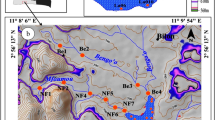Abstract
The paper presents the mineral and chemical compositions of carbonate, metalliferous, and ore-bearing sediments developed within the Pobeda ore cluster based on the materials of stations 37L244g, 37L245g, and 37L184k by the chemical, optical, electron microscopic, electron probe, and X-ray methods. The compositions are compared with those of background biogenic carbonate sediments developed beyond the hydrothermal cluster. The results revealed that the hydrothermal activity zone is marked by various types of mineral and geochemical zoning: (1) increase in the ore element concentration downward the sediment section leading to a downsection change of carbonate sediments by the ore-bearing variety (St. 37L184k); (2) layer-by-layer enrichment of sediments with ore components (St. 37L244g); and (3) confinement of concentration zones to the roof, middle part, and bottom of sedimentary deposits (St. 37L245g). The relationship of various types of mineral and geochemical zoning with the physical and chemical parameters of interstitial waters in the metalliferous and ore-bearing sediments is considered.










Similar content being viewed by others
REFERENCES
Astakhova, N.V., Kolesnik, O.N., and S"edin, V.T., Ore mineralization in volcanic rocks from the submarine rises of the Sea of Japan, Geochem. Int., 2014, no. 2, pp. 144–161.
Bel’tenev, V.E., Rozhdestvenskaya, I.I., Samsonov, I.K., et al., Prospecting in the Russian exploration area in the Atlantic Ocean, with estimation of perspective reserves (categories P2 and P3 in blocks 31–45, in Otchet 37-go reisa NIS “Professor Logatchev” (Report of Cruise 37 of the R/V Professor Logatchev), Funds AO PMGRE, 2016.
Bich, A.S., Metalliferous sediments in the Pobeda ore cluster (MAR 17°08′ N), in Novoe v poznanii protsessov rudoobrazovaniya (New Materials on Understanding Processes of Ore Formation), Moscow: IGEM RAN, 2017, pp. 62–65.
Bich, A.S. and Petrov, A.Yu., Study of metalliferous sediments for reconstructing processes of the hydrothermal ore formation with Pobeda ore cluster in MAR as example, in Metallogeniya drevnikh i sovremennykh okeanov (Metallogeny of Ancient and Modern Oceans), Miass: IMin UrO RAN, 2018, pp. 89–93.
Blinov, I.A., Hypergene zinc minerals in sulfide deposits in the South Urals, Extended Abstract of PhD (Geol.–Miner.) Dissertation, St. Petersburg, 2016.
Cocco G., Fanfani L., and Zanazzi P.F., The crystal structure of tarbuttite, Zn2(OH)PO4, Z. Kristallogr. Cryst. Mater., 1966, no. 123, pp. 321‒329.
Gablina, I.F., Dobretsova, I.G., and Popova, E.A., Biomineralization processes during the formation of modern oceanic sulfide ore and ore-bearing sediments, in Biogenic-Abiogenic Interactions in Natural and Anthropogenic Systems, Frank-Kamenetskaya, O.V., Panova, E.G., and Vlasov, Yu.D., Eds., Berlin: Springer, 2016, pp. 43‒54.
Gablina, I.F., Dmitrenko, O.B., Os’kina, N.S., et al., Impact of hydrothermal activity on carbonate fossils in bottom sediments of the tropical Atlantic, Oceanology, 2015, vol. 55, no. 1, pp. 100–111.
Gablina, I.F., Dobretsova, I.G., Narkevskii, E.V., et al., Influence of hydrothermal-metasomatic processes on the formation of present-day sulfide ores in carbonate bottom sediments of the Mid-Atlantic Ridge (19°–20° N), Lithol. Miner. Resour., 2017, no. 5, pp. 335–357.
Gablina, I.F., Dobretsova, I.G., Laiba, A.A., et al., Specific features of sulfide ores in the Pobeda hydrothermal cluster, Mid-Atlantic Rise 17°07′–17°08′ N, Lithol. Miner. Resour., 2018, no. 6, pp. 431–454.
Gablina, I.F., Dmitrenko, O.B., Khusid, T.A., and Libina, N.V., Influence of fluids on the species composition and preservation of microfossils in biogenic carbonate sediments in the Pobeda hydrothermal cluster (Mid-Atlantic Ridge), Lithol. Miner. Resour., 2019, no. 6, pp. 511–523.
Khusid, T.A., Os’kina, N.S., Lukashina, N.P., et al., Benthic and plankton foraminifers in hydrothermally active zones of the Mid-Atlantic Ridge (MAR), Stratigr. Geol. Correl., 2018, vol. 26, no. 1, pp. 109–119.
Kolesnik, O.N., S”edin, V.T., Kolesnik, A.N., Yaroshchuk, E.I., and Karabtsov, A.A., Overlapping ore mineralization of volcanic rocks from the Sea of Japan: New data, Dokl. Earth Sci, 2019, vol. 487, no. 1, pp. 786–790.
Lipkina, M.I., Phosphate and associated mineralization in magmatic rocks of the Chentsov Seamount (Sea of Japan), Tikhookean. Geol., 1998, vol. 17, no. 3, pp. 81–93.
Nikolaeva, E.P., Colloform zincite from the Angren coals, Dokl. Akad. Nauk UzSSR, 1968, no. 2, pp. 44–45.
Popova, E., Gablina, I., Bel’tenev, V., and Dobretsova, I., Features of sedimentation in the Pobeda-2 hydrothermal ore field and the Pobeda-3 ore manifestation in the Russian exploration area (mid-Atlantic ridge), in Joint International Conference “Minerals” of the Ocean-9”, St. Petersburg: VNIIOkeangeologia, 2018, pp. 140‒143.
Shterenberg, L.E. and Voronin, B.I., Zincite (ZnO) clasts in sediments from Site 655 (NE Pacific), Byull. Komiss. Izuch. Chetvert. Perioda, 1990, no. 59, pp. 129–135.
Spencer, L.J., On hopeite and other zinc phosphates and associated minerals from the Broken Hill mines, North-Western Rhodesia, Mineral. Mag., 1908, vol. 15, no. 68, pp. 1–38.
Trofimov, O.V., Zaikov, V.V., Sergeev, N.B., and Maslennikova, S.P., Zona okisleniya Gaiskogo mednokolchedannogo mestorozhdeniya (Oxidation Zone in the Gai Massive Sulfide Copper Deposit), Miass: Inst. Mineral. UrO RAN, 1992.
Zaikov, V.V. and Maslennikova, S.P., Structure and composition of the oxidation zone in the Gai massive sulfide copper deposit, in Mineraly i mineral’noe syr’e Urala (Minerals and Mineral Resources in the Urals), Yekaterinburg: UrO RAN, 1992, pp. 99–117.
Zhivopistsev, V.P. and Selezneva, E.A., Analiticheskaya khimiya tsinka (Analytical Chemistry of Zinc), Moscow: Nauka, 1975.
ACKNOWLEDGMENTS
The authors express deep gratitude to all participants of Cruise 37 of the R/V Professor Logatchev for participation in the collection of research material; to L.L. Demina, E.V. Pokrovskaya, M.E. Gorshkova for help in the preparation of samples and accomplishment of analyses; as well as to A.I. Mikhailova and N.V. Libina for help in the paper layout.
Funding
This work was carried out under the State Task of the Ministry of Education and Science of the Russian Federation (themes: GIN RAN no. 0135-2019-0050 and IO RAN no. 0149-2019-0007).
Author information
Authors and Affiliations
Corresponding author
Additional information
Translated by D. Sakya
Rights and permissions
About this article
Cite this article
Gablina, I.F., Dobretsova, I.G., Popova, E.A. et al. Mineral Composition and Geochemical Zoning of Bottom Sediments in the Pobeda Hydrothermal Cluster (17°07.45′ N–17°08.7′ N Mid-Atlantic Ridge). Lithol Miner Resour 56, 113–131 (2021). https://doi.org/10.1134/S0024490221020036
Received:
Revised:
Accepted:
Published:
Issue Date:
DOI: https://doi.org/10.1134/S0024490221020036




